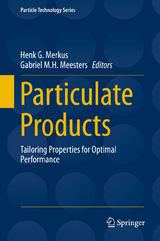Particulate Products
Springer International Publishing (Verlag)
978-3-319-00713-7 (ISBN)
Particulate products make up around 80% of chemical products, from all industry sectors. Examples given in this book include the construction materials, fine ceramics and concrete; the delicacies, chocolate and ice cream; pharmaceutical, powders, medical inhalers and sun screen; liquid and powder paints. Size distribution and the shape of the particles provide for different functionalities in these products. Some functions are general, others specific. General functions are powder flow and require - at the typical particulate concentrations of these products - that the particles cause adequate rheological behavior during processing and/or for product performance. Therefore, this book addresses particle packing as well as its relation to powder flow and rheological behavior. Moreover, general relationships to particle size are discussed for e.g. color and sensorial aspects of particulate products. Product-specific functionalities are often relevant for comparable product groups. Particle size distribution and shape provide, for example, the following functionalities:
- dense particle packing in relation to sufficient strength is required in concrete construction, ceramic objects and pharmaceutical tablets
- good sensorial properties (mouthfeel) to chocolate and ice cream
- effective dissolution, flow and compression properties for pharmaceutical powders
- adequate hiding power and effective coloring of paints for protection and the desired esthetical appeal of the objects
- adequate protection of our body against sun light by sunscreen
- effective particle transport and deposition to desired locations for medical inhalers and powder paints.
Adequate particle size distribution, shape and porosity of particulate products have to be achieved in order to reach optimum product performance. This requires adequate management of design and development as well as sufficient knowledge of the underlying principles of physics and chemistry. Moreover, flammability, explosivity and other health hazards from powders, during handling, are taken into account. This is necessary, since great risks may be involved. In all aspects, the most relevant parameters of the size distribution (and particle shape) have to be selected.
In this book, experts in the different product fields have contributed to the product chapters. This provides optimum information on what particulate aspects are most relevant for behavior and performance within specified industrial products and how optimum results can be obtained. It differs from other books in the way that the critical aspects of different products are reported, so that similarities and differences can be identified. We trust that this approach will lead to improved optimization in design, development and quality of many particulate products.
Dr Henk G. Merkus has been working at Delft University of Technology for about 35 years, the last 20 years of it in Particle Characterization in the Particle Technology Group of prof. Brian Scarlett. Also, for about 15 years he has been a member of ISO/TC24 on Sieving and Other Methods for Particle Size Measurement and he still is. Retired now the author is active in giving courses on this subject, in the Netherlands as well as in Sweden and the United Kingdom. Dr Merkus is the author of the Springer book "Particle Size Measurements" (2009). Dr Ir Gabriel M.H. Meesters is affiliated to DSM Food Specialities and Delft University of Technology Delft. He has 10 patents filed and 5 issued, and will be one of the organizers of the technical program of PARTEC 2013 in Nuremberg, Germany.
Preface.- 1 Introduction by Henk G. Merkus and Gabriel M.H. Meesters.- 2 Basic Information for Design of Particulate Products by G. Henk Merkus.- 3 Measurement of Particle Size, Shape, Porosity and Zeta-potential by Henk G. Merkus.- 4 Assessment and Control of Fire and Explosion Hazards and Risks of Particulates by Saul M. Lemkowitz and Hans J. Pasman.- 5 Particle and Fiber Toxicology by Georgia K. Hinkley and Stephen M. Roberts.- 6 Ceramics - Effect of Powder and Slurry Properties on Quality by Makio Naito.- 7 Chocolate.- 8 Propellants.- 9 Dry powder inhalers.- 10 Powder coatings.- 11 The role of particle size in drug release and absorption.- 12 Pharma powders.- 13 Powder coatings and the effects of particle size.- 14 An Overview of Physical (Particulate) Sunscreen by David Fairhurst.- 15 Increased Antimicrobial Cctivity of Cheese Coatings through Particle Size Reduction by Gabriel M.H. Meesters and Stephen L.A. Hennart.
| Erscheint lt. Verlag | 2.12.2013 |
|---|---|
| Reihe/Serie | Particle Technology Series |
| Zusatzinfo | XVIII, 469 p. 151 illus., 72 illus. in color. |
| Verlagsort | Cham |
| Sprache | englisch |
| Maße | 155 x 235 mm |
| Gewicht | 489 g |
| Themenwelt | Naturwissenschaften ► Physik / Astronomie ► Atom- / Kern- / Molekularphysik |
| Naturwissenschaften ► Physik / Astronomie ► Festkörperphysik | |
| Naturwissenschaften ► Physik / Astronomie ► Thermodynamik | |
| Schlagworte | BET Method • Dynamic Light Scattering • Effective Particle Density • Elementarteilchen • Green Body • Industrial Particle R&D • Industrial Particle R&D • laser diffraction • Mercury Porosimetry • Microscopy and Image Analysis • Paint Technology • Particle Size and Analysis • Particle Size Distribution PSD • Particulate materials • Process Control • Product Development and Design • Product specifications • Quality Function Deployment QFD • Rheology of Particle Suspentions • Silicon Nitride and Alumina Ceramics • Specific Surface Area • Static Light Scattering • Zeta Potential |
| ISBN-10 | 3-319-00713-0 / 3319007130 |
| ISBN-13 | 978-3-319-00713-7 / 9783319007137 |
| Zustand | Neuware |
| Informationen gemäß Produktsicherheitsverordnung (GPSR) | |
| Haben Sie eine Frage zum Produkt? |
aus dem Bereich




